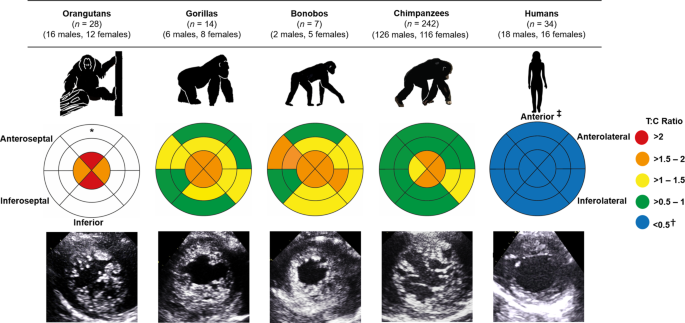2024-06-14 スウォンジー大学
<関連情報>
- https://www.swansea.ac.uk/press-office/news-events/news/2024/06/study-on-architecture-of-heart-offers-new-understanding-of-human-evolution.php
- https://www.nature.com/articles/s42003-024-06280-9
ヒト科における左室海綿状構造:ヒト心臓表現型の分岐 Left ventricular trabeculation in Hominidae: divergence of the human cardiac phenotype
Bryony A. Curry,Aimee L. Drane,Rebeca Atencia,Yedra Feltrer,Thalita Calvi,Ellie L. Milnes,Sophie Moittié,Annika Weigold,Tobias Knauf-Witzens,Arga Sawung Kusuma,Glyn Howatson,Christopher Palmer,Mike R. Stembridge,John E. Gorzynski,Neil D. Eves,Tony G. Dawkins & Rob E. Shave
Communications Biology Published:14 June 2024
DOI:https://doi.org/10.1038/s42003-024-06280-9

Abstract
Although the gross morphology of the heart is conserved across mammals, subtle interspecific variations exist in the cardiac phenotype, which may reflect evolutionary divergence among closely-related species. Here, we compare the left ventricle (LV) across all extant members of the Hominidae taxon, using 2D echocardiography, to gain insight into the evolution of the human heart. We present compelling evidence that the human LV has diverged away from a more trabeculated phenotype present in all other great apes, towards a ventricular wall with proportionally greater compact myocardium, which was corroborated by post-mortem chimpanzee (Pan troglodytes) hearts. Speckle-tracking echocardiographic analyses identified a negative curvilinear relationship between the degree of trabeculation and LV systolic twist, revealing lower rotational mechanics in the trabeculated non-human great ape LV. This divergent evolution of the human heart may have facilitated the augmentation of cardiac output to support the metabolic and thermoregulatory demands of the human ecological niche.


